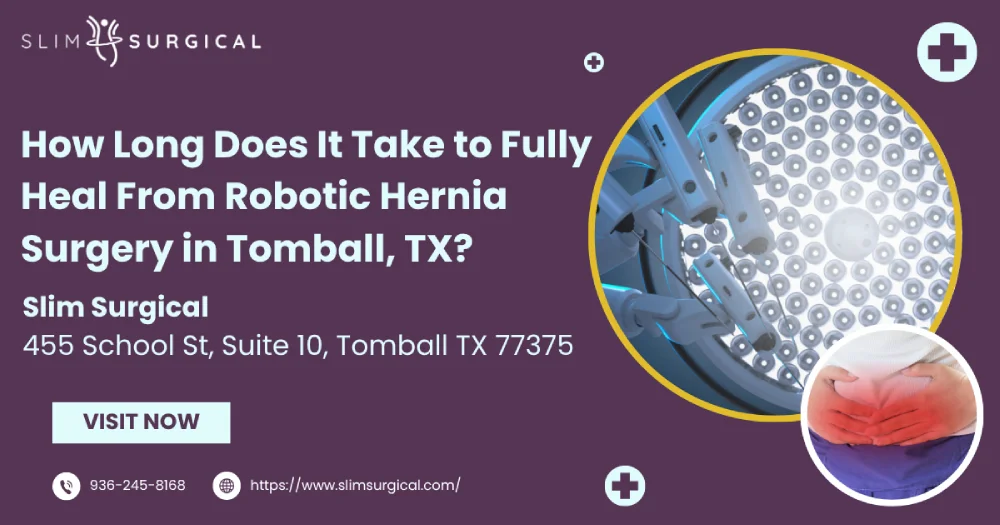
If you’re considering or recovering from robotic hernia surgery in Tomball, TX, you’re likely wondering: how long does it take to fully heal from robotic hernia surgery Tomball, TX? That’s a common concern—and a key question for anyone preparing for a hernia procedure. Recovery after robotic hernia repair is generally smoother due to its minimally invasive surgical techniques, which are now a preferred alternative to traditional open surgery for many patients.
Full recovery from robotic hernia surgery in Tomball, TX, typically takes 4 to 6 weeks, with most patients able to return to normal activities within that timeframe.
Here, we’ll outline the typical recovery timeline, explore factors influencing hernia surgery recovery, and offer guidance to help you resume daily activities as soon as possible. Whether you are facing an inguinal hernia, ventral hernia, or another type of hernia, understanding what affects your recovery from minimally invasive hernia repair is essential for a successful outcome.
With advances in minimally invasive surgery and robotic-assisted hernia repair, recovery timelines have improved significantly. Robotic hernia surgery involves smaller incisions in the abdominal wall, often leading to faster recovery and less pain or discomfort than open inguinal or ventral hernia repair. Here's a closer look at what you can expect in the weeks after surgery in Tomball, TX:
| Recovery Phase | Timeframe | What to Expect |
|---|---|---|
| Immediate Post-Op (Recovery Room) | 24-72 hours | Soreness near the incision, mild swelling; light activity encouraged to reduce the risk of blood clots. |
| Early Recovery | Days 3-7 | Gradual return to daily activities; minimal swelling, less pain; able to walk and move around the house. |
| Return to Light Activities | 7-14 days | Many patients can return to work (non-strenuous), drive, and begin light walking. Desk work and non-strenuous activities are usually safe. |
| Resume Most Activities | 2-4 weeks | More normal activities resumed, gentle exercise, non-strenuous chores; still avoid heavy lifting to reduce the risk of hernia recurrence. |
| Full Recovery | 4-6 weeks | Able to undertake strenuous activities, heavy lifting, vigorous exercise; recovery after robotic hernia generally complete for most patients. |
Immediately after robotic hernia surgery in Tomball, you'll recover in the recovery room before discharge—same-day surgery is possible for most. Soreness around the incision, some bruising, and mild swelling are normal. Light movement (such as walking) is encouraged as part of minimally invasive hernia recovery to reduce risks such as blood clots or complications. Pain medication may be prescribed, but patients often experience less pain due to the minimally invasive approach compared to open hernia repair.
Most patients feel a marked improvement within the first week, with reduced pain and increased mobility. Light chores, short walks, and independent self-care are usually possible at this stage. If cleared by your hernia surgeon, many can drive or return to work (especially desk jobs) about 7-14 days post-op. If you underwent laparoscopic inguinal hernia repair or robotic inguinal hernia repair, the recovery time compared to open or complex hernia surgeries is often shorter.
Recovery after hernia repair surgery varies depending on personal and surgical factors. Let's look at what might impact your healing and recovery timeline in Tomball, TX:
The specific type of hernia (such as inguinal hernia, ventral hernia, or hiatal hernia) or complex and large hernia repairs might require longer restriction periods. Emergency surgery or recurrent hernia cases can also lengthen the recovery timeline.
Rarely, some patients experience increased pain, infection, or mesh issues after hernia repair in Houston or Tomball. Adhering to all guidelines and following up with your hernia specialist will help you achieve a successful recovery.
For the best results after robotic hernia surgery, taking proactive steps and following all recommendations will promote quicker recovery:
Choosing robotic hernia repair or laparoscopic inguinal hernia repair offers a minimally invasive option which comes with distinct advantages. Here’s why so many patients and surgeons in Tomball, TX, opt for robotic-assisted surgery:
Robotic-assisted hernia surgery typically offers a minimally invasive experience, whether you’re a candidate for robotic inguinal hernia repair, ventral hernia repair, or other complex hernia surgeries. Discuss your suitability with experienced hernia surgeons like Dr. Brian Harkins or a local hernia specialist in TX to ensure the best approach for your case.
Most patients fully recover in 4 to 6 weeks, but many resume light activity within one week. Your timeline depends on the type of hernia, surgical complexity, and your overall health. Following post-op care instructions helps ensure a smoother and quicker recovery.
Yes, robotic-assisted laparoscopic surgery is commonly performed for inguinal hernia repair. This technique offers the benefits of minimally invasive hernia repair, including reduced postoperative pain and quicker return to normal activities compared to traditional open inguinal hernia surgery.
Most modern hernia surgeries, including minimally invasive and robotic hernia repair, utilize mesh to reinforce the abdominal wall. This reduces the risk of hernia recurrence and provides long-term support. However, the type of mesh or technique may depend on your specific hernia and surgeon’s preferences.
The timeframe to return to work depends on your job and the complexity of the hernia. Many patients with desk jobs or non-strenuous duties can resume work in 1-2 weeks after surgery, while jobs involving heavy lifting or strenuous activity may require up to six weeks or surgeon’s clearance.
Yes, you should avoid heavy lifting, strenuous activities, and vigorous exercise until cleared by your hernia surgeon. Restrictions after robotic hernia vary by your recovery progress and the type of surgery. Following all advice helps reduce risk of hernia recurrence and supports a smoother recovery.
Your candidacy for robotic hernia surgery is determined by your overall health, hernia size, and complexity. Patients with large, complex, or recurrent hernias, or underlying health concerns may need alternative techniques. Consultation with a hernia specialist in Tomball, TX, is essential for individualized advice.
A hernia specialist oversees your care before and after surgery, tailoring the approach for faster and safer recovery. They develop your personalized plan, manage pain, follow up on healing, and are equipped to address complications should they arise during the weeks after surgery.
Robotic and laparoscopic hernia repair techniques are associated with less nerve damage and tissue disruption, reducing the likelihood of persistent or chronic pain after hernia surgery. The minimally invasive approach provides a more comfortable recovery compared to traditional open techniques.
Most hernia recurrences are not emergencies, but some symptoms like severe pain, swelling, or inability to push the hernia back require urgent care. Prompt follow-up with your hernia surgeon in Tomball, TX, ensures swift intervention if necessary, reducing the risk of complications.
Yes, benefits of robotic hernia surgery include less scarring, lower long-term risk of hernia recurrence, quicker return to daily activities, and often a better quality of life. Ongoing research supports its increasing use as an advanced alternative to traditional open surgery for hernia repair in Houston and Tomball areas.

Start your journey toward health and confidence with Slim Surgical. Our expert surgeon is here to guide you every step of the way with advanced care tailored to your goals.

2025 Slim Surgical. All right reserved. Website Design & SEO By: Authority Solutions®